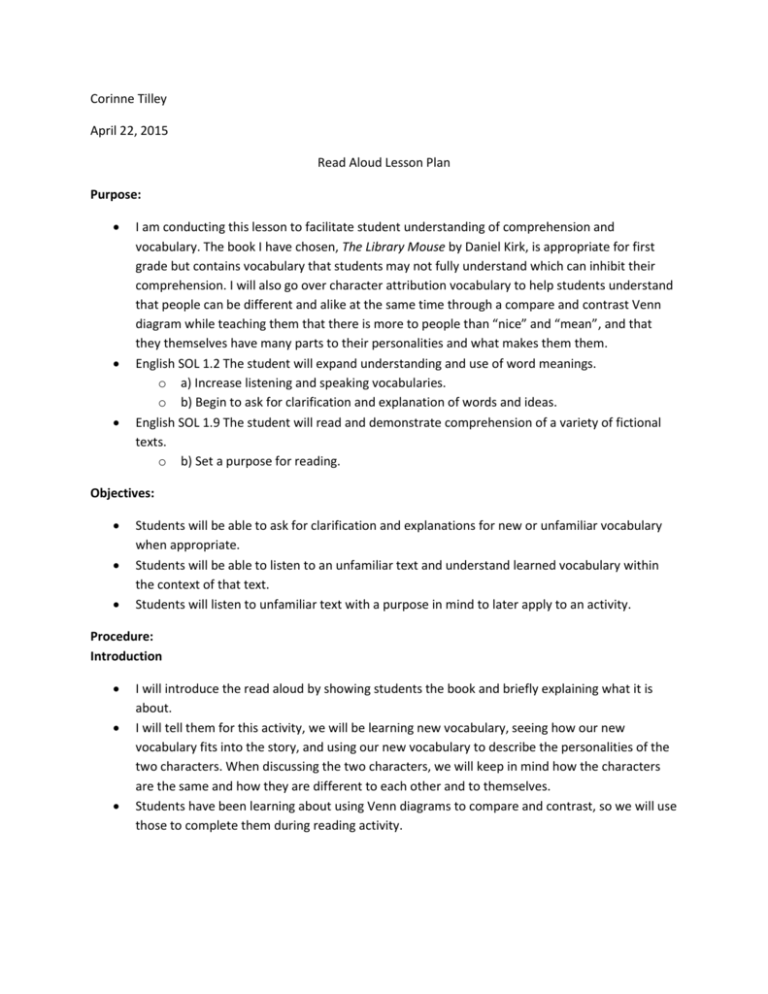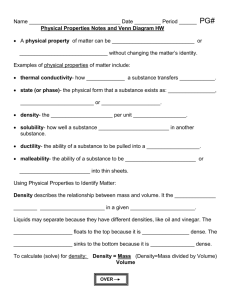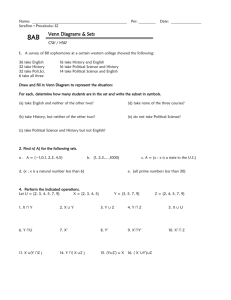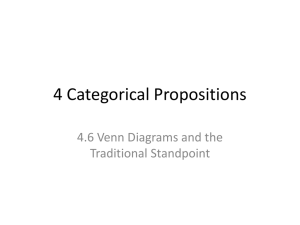Read Aloud Lesson Plan
advertisement

Corinne Tilley April 22, 2015 Read Aloud Lesson Plan Purpose: I am conducting this lesson to facilitate student understanding of comprehension and vocabulary. The book I have chosen, The Library Mouse by Daniel Kirk, is appropriate for first grade but contains vocabulary that students may not fully understand which can inhibit their comprehension. I will also go over character attribution vocabulary to help students understand that people can be different and alike at the same time through a compare and contrast Venn diagram while teaching them that there is more to people than “nice” and “mean”, and that they themselves have many parts to their personalities and what makes them them. English SOL 1.2 The student will expand understanding and use of word meanings. o a) Increase listening and speaking vocabularies. o b) Begin to ask for clarification and explanation of words and ideas. English SOL 1.9 The student will read and demonstrate comprehension of a variety of fictional texts. o b) Set a purpose for reading. Objectives: Students will be able to ask for clarification and explanations for new or unfamiliar vocabulary when appropriate. Students will be able to listen to an unfamiliar text and understand learned vocabulary within the context of that text. Students will listen to unfamiliar text with a purpose in mind to later apply to an activity. Procedure: Introduction I will introduce the read aloud by showing students the book and briefly explaining what it is about. I will tell them for this activity, we will be learning new vocabulary, seeing how our new vocabulary fits into the story, and using our new vocabulary to describe the personalities of the two characters. When discussing the two characters, we will keep in mind how the characters are the same and how they are different to each other and to themselves. Students have been learning about using Venn diagrams to compare and contrast, so we will use those to complete them during reading activity. Development Once the book has been presented to the students, I will go through a list of vocabulary that I believe first graders may not be familiar with that appears in the book. *See Teacher Notes I will then go through a list of appropriate vocabulary that does not necessarily appear in the book, but could be used to describe the book characters’ personalities. These will appear in a word bank and will be explained orally by either me or any student who can tell what they mean. Before we begin reading, I will give students a Venn diagram that compares and contrasts the two main characters, Sam and Sarah. For the sake of time, the Venn diagram will include a word bank of personality traits that could apply to either or both of the characters that may be difficult for students to spell. I will ask students to pay close attention while listening to me read so that they can fill in their Venn diagrams with whichever personality traits they feel apply to either or both of the characters. Students will be told that they can write any characteristics in their Venn diagram, not just the ones provided. Students will be encouraged to raise their hands to ask or to clarify what a word, phrase, or concept means if they are unsure. When we are done with the read aloud, I will ask students to talk about their Venn diagrams: why they put certain traits for certain characters, why they didn’t, and how they can justify their choices using evidence from the text. Students will be asked if they can relate to any of the characters, why or why not, and what they think that means to them. Students will be asked if any of the specific character traits apply to them and why. Summary I will close the lesson by showing them what they have done. I will tell them that they learned new words, were able to understand their new words when they appeared in the story, that they were able to listen to the book and think about what was being said at the same time, and that they were able to apply and discuss what those words meant in a larger context. I will show them that, based on their diagrams, it seems that people can get along and be friends even if they are very different because everyone has something in common. Materials: The Library Mouse by Daniel Kirk Venn diagram worksheet with word bank List of personality traits vocabulary Pencils and paper Evaluation Part A: I will assess student knowledge by asking them questions relating to the book and activity. o What words did you learn? o Can you relate to either character? Why or why not? o Are there any personality traits that you wrote down that apply to you? Why do you think this? o Do you think you could get along with either of the characters? Why or why not? Students will be assessed through how often they use their new vocabulary in their answers and whether or not they demonstrate that they understand that people can be alike and different and that different types of people can get along. Evaluation Part B: Did the students meet your objectives? How do you know? o The students mostly met my objectives. During the reading activity, students got excited every time I read a word in the book that we had discussed during the “before reading” activity. If they had forgotten what the word meant, or didn’t know what something else was in the book, like “The Pyramids”, they asked me. When they did have their “aha! I know what that means!” moments I asked them for clarification and they were able to tell me what the previously unfamiliar word meant in that context. Where students had trouble was with the after reading discussion. For the most part, they did not have a real grasp on the concept of a personality or how we can use words to describe ourselves outside of physical characteristics. For example, “mice” was written in the center of many Venn diagrams. Did your lesson accommodate/address the needs of all your students? o I had an issue with one student who I suspect may have ADD/ADHD. He was very antsy and visibly (and vocally) eager to end the activity, though he didn’t want to return to the classroom, either. Granted, the book was quite long, but that day had also been unexpectedly long and he had not had a proper gym or recess period to let out all of his energy. Also, it was career day (teachers had not been informed) and there was a police dog that had frightened him quite a bit, so that may be part of it. Still, once we got through the book he was much more engaged for the after reading discussion. What were the strengths of the lesson? o The lesson ended up working out because of the great discussion between the students and between myself and the students. Though they had trouble understanding the concept of a personality, I could tell they were really trying to understand. They were using the words I had defined for them to describe themselves and each other (“Zaria is shy and I’m outgoing, but she’s my best friend!”), and were connecting the words with the book. There was even debate amongst the students about whether one of the characters was too mean or not, and students used specific examples from the text to justify their answers. What were the weaknesses? o I believe we were all victims of circumstance with regard to the surprise career day and heavy police/police dog presence that made so many of the students uncomfortable, but I do still think the book was too long. Part of the reason I think some students thought a particular character was “mean” was because they weren’t able to focus on the story long enough to get to the end. How would you change the lesson if you could teach it again? o I would choose a different book with similar themes and I would use simpler words to get students to understand what a personality is. I was under the impression that this would be prior knowledge and that the concept of “nice” and “mean” would be already understood, but it clearly wasn’t and I had to adjust on the fly. It worked out, students were still listening to the story with the purpose of figuring out who was “nice” and “mean” and how each character was similar and dissimilar, but I initially gave them way too much new information for them to process. Teacher Notes Book Vocabulary Reference book: a nonfiction book where you can look up information or something you want to know Stroll: casually/slowly walk Atop: on top of Gazing: looking at something you like or find interesting, admiring Pored: looking over thoroughly, like it’s important or very interesting Warily: carefully, like you’re unsure




